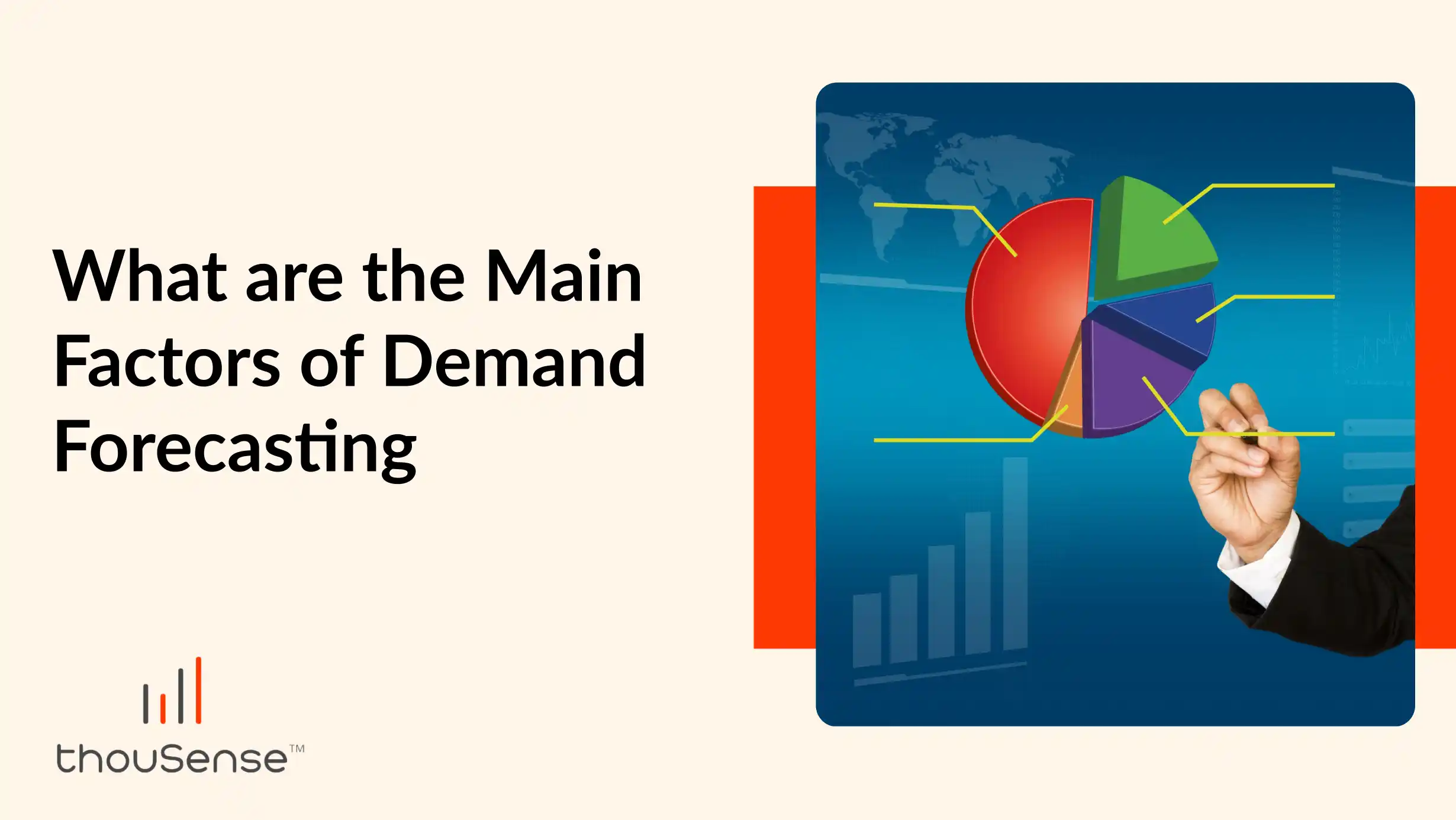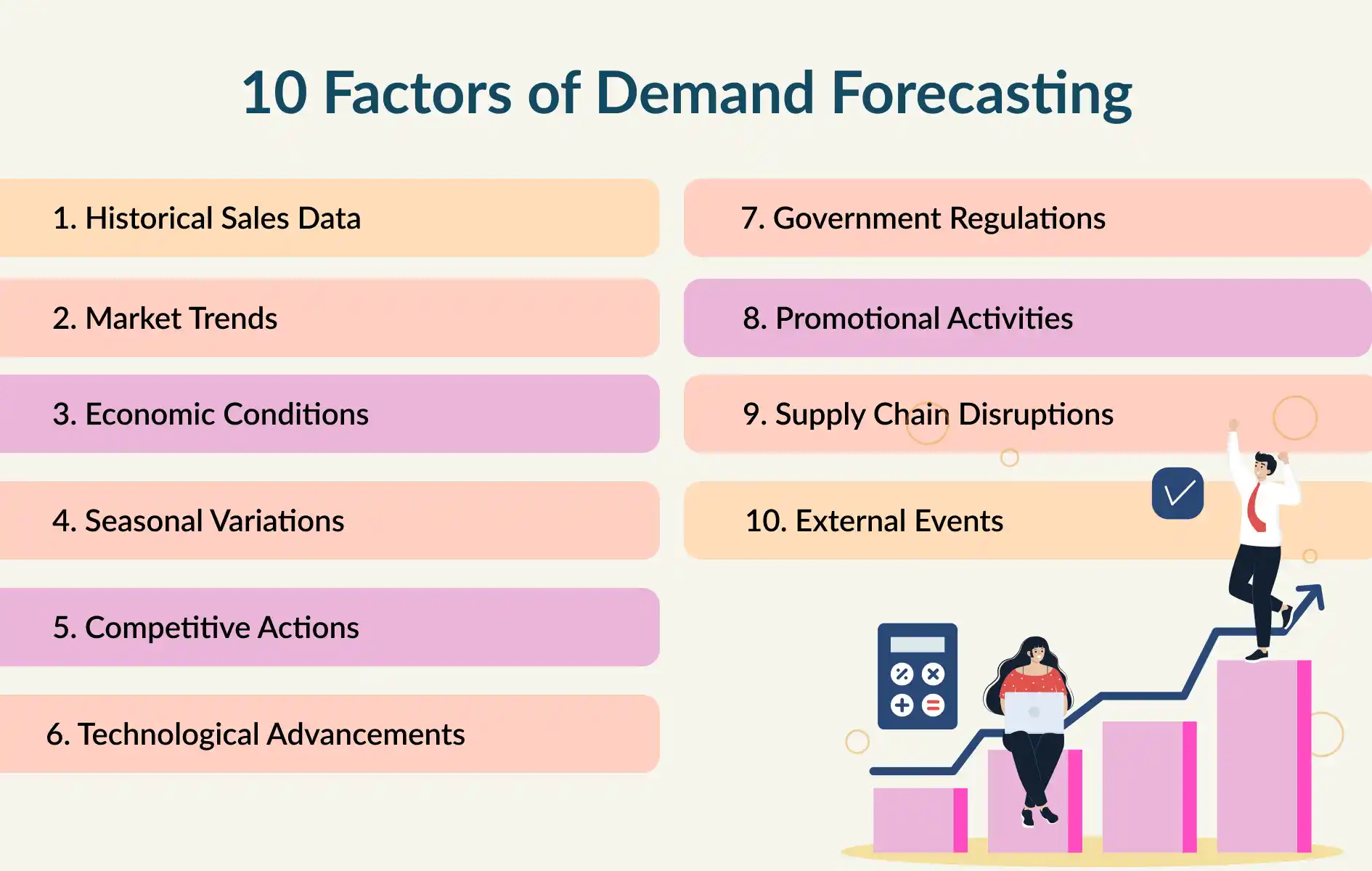What are the Main Factors of Demand Forecasting | thouSense

In the highly competitive business environment, businesses need to think ahead to stay successful. One important tool for planning is demand forecasting. This helps companies predict what customers will want, use their resources wisely, and make smart decisions based on facts. Whether you have a small business or a big company, demand forecasting is important for working better, saving money, and earning more profits.
In this blog, we will look at the main factors of demand forecasting and how businesses can learn more about future needs by thinking about these factors.
What is Demand Forecasting?
Demand forecasting is when a business tries to predict how many products or services customers will want in the future. They look at things like past sales, what’s happening in the market, and other factors to figure this out. By doing this, they can plan how many items they need to have ready.
Getting the forecast right is important for how the business runs. It helps them manage their stock, plan how much to make, and decide how to spend their money. A reliable demand forecast ensures that a company maintains optimal inventory levels, avoiding stockouts while minimizing excess inventory, thus balancing supply with customer demand efficiently.
10 Main Factors of Demand Forecasting
Several factors influence the accuracy and reliability of demand forecasting. Businesses need to understand these factors of demand forecasting if they want to make better predictions about market changes. Here are the main factors that impact demand forecasting:

1. Historical Sales Data
Historical sales data is the most basic part of demand forecasting. It includes past sales numbers, what people like to buy, and how they buy. By looking at this information, businesses can find patterns and cycles that might happen again in the future.
Why it matters: Historical data helps make more accurate predictions and find trends.
Challenges: If the data is incomplete or inaccurate, the forecasts can be wrong, especially for products that don’t have regular sales patterns.
2. Market Trends
Market trends are very important when estimating demand. Changes in how people shop, new technologies, or shifts in the industry can strongly affect future demand. For example, more people are now interested in eco-friendly products, which could increase demand for sustainable goods.
Why it matters: Understanding market trends helps businesses adjust their forecasts based on changing customer preferences.
Challenges: If market conditions change too fast or in unexpected ways, it becomes harder to rely only on past data, especially when trends suddenly shift.
3. Economic Conditions
Economic factors like inflation, job levels, and the economy’s overall health are also very important in demand forecasting. If the economy is not doing well or people have less money to spend, the demand for some products and services will go down.
Why it matters: The economy affects how much money people have to spend and the overall health of the market, which influences demand in different industries.
Challenges: When the economy is uncertain due to changes in government rules, global events, or disruptions in the market, it makes forecasting harder.
4. Seasonal Variations
Some products see changes in demand based on the season. For example, retail sales usually go up during holidays, and people buy more warm clothes in the winter. Knowing these patterns helps businesses have enough stock when needed but avoid having too much during slower times.
Why it matters: Seasonal trends give businesses a chance to prepare for predictable changes in demand.
Challenges: If companies don’t consider seasonal patterns, they might end up with too much stock during slow periods or not enough when demand is high.
5. Competitive Actions
Actions taken by competitors, including product debuts, pricing methods, and marketing strategies, may greatly affect the demand for a business. If a rival brings a similar product to the market at a cheaper price, it could cause a decrease in demand for what you offer, resulting in the need to revise your forecast. This is one of the most overlooked factors of demand forecasting.
Why it matters: Businesses that monitor their competitors can respond quickly to market changes and adjustments in demand levels.
Challenges: Unexpected actions from competitors cause a variation in demand forecasts.
6. Technological Advancements
New technology innovations can either give rise to new demand or make existing products irrelevant. The increase in smartphones has dramatically lowered the demand for conventional digital cameras. In a number of cases, new innovations in the production processes or distribution networks could reshape demand patterns by improving efficiency or lowering costs.
Why it matters: Progress in technology changes industries and impacts how customers expect to be treated.
Challenges: The speed of technological development may surpass conventional forecasting methods, thus requiring more adaptable approaches.
7. Government Regulations
Policy transformations from the government, specifically regulations, and tariffs, might change demand by modifying the costs associated with goods and services. By way of example, tougher environmental standards might boost the need for energy-efficient appliances, and new tariffs might drive up the price of importing raw materials, thus affecting both supply and pricing.
Why it matters: Supply-chain dynamics and consumer preferences might be influenced by upcoming regulatory changes.
Challenges: The uncertainties experienced in regulatory settings cause an increase in the complexity of demand predictions, especially during times of frequent policy adjustments.
8. Promotional Activities
Discounts, marketing promotions, and marketing usually lead to fleeting increases in demand. Anticipating and handling short-term demand surges is something that recognizing the effects of promotional efforts can support businesses in doing.
Why it matters: Promotions can boost sales, helping businesses clear stock or introduce new products.
Challenges: The impact of promotional activities can vary depending on factors like customer reception, timing, and market saturation.
9. Supply Chain Disruptions
Unexpected supply chain issues—such as delays, shortages, or changes in supplier relationships—can impact product availability, which in turn affects demand.
Why it matters: Understanding potential supply chain risks helps businesses anticipate their impact on demand.
Challenges: Supply chain disruptions are often unpredictable, requiring businesses to remain agile and adjust forecasts accordingly.
10. External Events
Events like natural disasters, political unrest, and pandemics can dramatically influence consumer behavior and market conditions. The COVID-19 pandemic is a prime example of how external events can disrupt global supply chains, alter customer needs, and challenge even the best forecasting models.
Why it matters: External events can have immediate and long-term effects on demand.
Challenges: The unpredictable nature of such events makes demand forecasting particularly challenging, necessitating flexible and adaptable forecasting strategies.
Conclusion
To stay quick, competitive, and successful in today’s changing markets, businesses must be good at predicting demand. By understanding the factors of demand forecasting, companies can improve their operations, make better predictions, and meet customer needs more effectively. The key is to choose the right method that fits your business, whether it’s looking at past data, watching market trends, or using advanced forecasting tools.
As markets keep changing, the ability to predict demand will be crucial for businesses that want long-term success.
FAQs
1. What are the factors of demand forecasting?
The major factors of demand forecasting are Historical Sales Data, Market Trends, Economic Conditions, Seasonal Variations, Competitive actions, Technological advancements, government regulations, promotional activities, and supply chain disruptions.
2. What is the most important factor in demand forecasting?
The most primary factor affecting demand forecasting is the historical sales data followed by market trends.